
Score breakdown
Things we like
- Refinement and performance of the V6 engine
- Comfort on- and off-road
- All-wheel drive ability on-road
Not so much
- Lack of ground clearance in stock form
- Could do with bigger tyres (name a 4x4 that doesn’t)
- Gear selector annoying to operate
On paper, there is so much to like about the new-generation 2023 Ford Ranger. It really seems like Ford engineers have studied the market and produced a ute with features Australian tradies and four-wheel drivers actually want in a new vehicle. It’s bigger than its predecessor; longer and wider.
It has the option of a V6 turbo-diesel motor (as tested), as well as permanent four-wheel drive, which has only been incorporated into vehicles such as the VW Amarok and Mitsubishi Triton previously.
There’s plenty to love about the idea of this new Ford Ranger, and it seems the internet agrees considering the popularity of Ranger content. But without actually spending time with it, and using it daily, there’s no way to separate the hype from fact.

The basics
| Engine | 3.0-litre V6 diesel (single turbo) |
|---|---|
| Max power | 184kW @ 3250rpm |
| Max torque | 600Nm @ 1750-2250rpm |
| 4x4 system | permanent four-wheel drive |
| ADR fuel claim | 8.4L/100km (combined) |
| Price | $70,190 + on-road costs |
I attended the initial launch of the Ranger last year, but we weren't allowed to drive the vehicle, or even look in the engine bay. This has all recently changed, and I was ecstatic to receive a call from Editor Matt saying it’s my turn for a spin in the top-of-the-line V6 Ranger Wildtrak.
Normally I don’t get excited by top-spec models as they include too many expensive additions and luxuries I just don’t need or want. But the Wildtrak, in my opinion, is the one to get; more on that later.
We headed out to the very wet Lithgow and Turon River area to put the new Ranger through familiar tracks and see how it would perform on dirt and off-road. This is beautiful country, filled with river crossings, mud, rocky climbs and amazing camping, all of which we were keen to explore in the 2022 V6 Ford Ranger Wildtrak.

Powertrain and performance
Combine a peppy 3.0L V6 turbo-diesel engine that produces 184kW at 3250rpm and 600Nm from 1750-2250rpm with a 10-speed automatic transmission, and it’s safe to say the new Ranger moves
It’s not just grunty though – it’s so smooth and refined in operation.
I actually jumped into a four-cylinder XLS Ford Ranger straight after the Wildtrak, and the first thing I noticed is how rough the four idles by comparison. In reality, it is just that the V6 is such a smooth motor it spoiled me as the 2.0L is still far quieter and smoother than most competitors.

Fuel economy hovered around 10.0L/100km on test but naturally, we weren’t driving with economy in mind. With a gentle right foot, this would see mid-eights, at a guess. With the factory Ford fuel tank coming in at 80L of capacity, it’s safe to assume a range of 750km per tank if being conservative.
The 10-speed gearbox is rather busy in operation but not what I’d call annoying. What I did find annoying was the actual gear selector, which has a small button at the front you need to press to change gears.
You get used to it, but I much prefer the more basic gear selector found in lower-spec Rangers. The upside to having a 10-speed transmission, though, is that there is a gear for any occasion when driving through technical terrain.

On-road ride and handling
The new Ranger's suspension is definitely firm but at no stage harsh or skittish, particularly unladen. It’s impressive in operation even over corrugations and fast dirt road sections. On-road, this firmness is appreciated, as the Ranger feels well planted and doesn’t roll through corners.
Combine well-handling suspension with the ability to run this particular Ranger in all-wheel drive on-road, and you have a vehicle that is stunning to drive in wet and slippery conditions. With disc brakes on all four corners, braking feel and performance is excellent also.
I had to keep reminding myself this is a four-wheel drive ute. The previous-generation Ranger always rode and handled well on Australian roads, thanks to local development and engineering, but this new Ranger is better again. An evolution if you will.
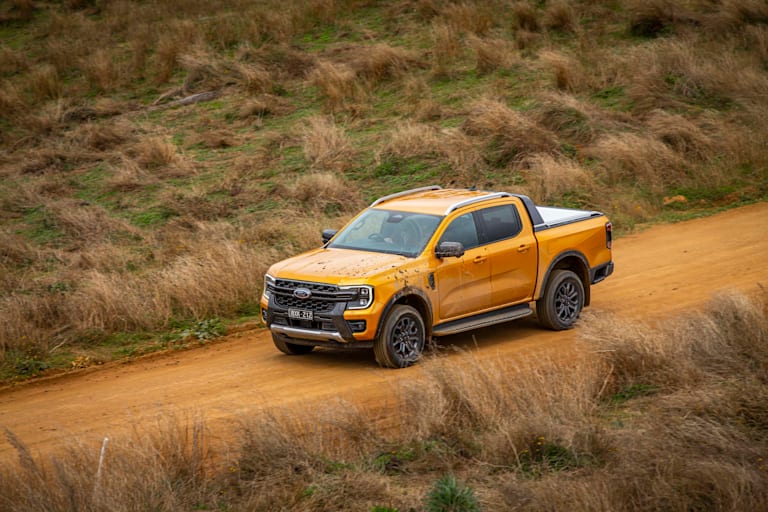
The previous-generation Ranger always rode and handled well on Australian roads, thanks to local development and engineering, but this new Ranger is better again
Something I appreciated was the operation of stability control, traction control and the various safety additions such as lane-keep assist, which were effective in operation but at no stage intrusive. This calibration was appreciated as someone who actually likes to drive a vehicle rather than have it drive for me so to speak.
There is a lack of annoying beeps and chimes, which was music to my ears. Speaking of music, the audio system in the Wildtrak Ranger is a ripper, both in terms of quality and volume output.
You certainly do notice the increase in size compared to the previous Ranger, mainly the increased width of both the cabin and wheel track. You get used to it, but you absolutely can feel it’s a bigger vehicle all round.
The extra wheelbase is a benefit on-road, not just to assist with load distribution. It also (in my opinion) enhances the grip and overall ride quality experienced. Will these larger dimensions hold the Ranger back off-road though? That’s what we need to find out.
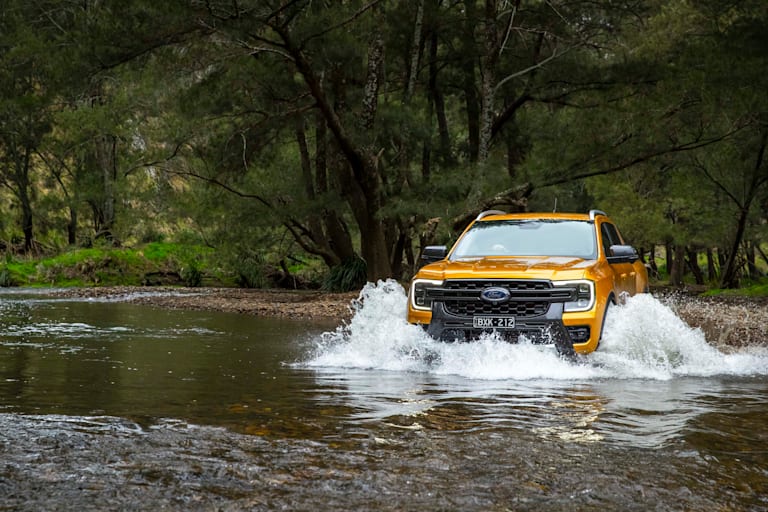
Off-road
In stock form, yes, I feel the extra length and width of the 2023 Ford Ranger are noticeable off-road, judging by the number of times we grazed the side steps, tow bar and underbody protection on tracks that other vehicles didn’t.
It’s certainly not as noticeable as a full-sized ute such as a Ram or Chevy Silverado but was noticeable in muddy ruts where it was a squeeze to sit in the tracks created by other vehicles.
Otherwise, the Ranger is a capable vehicle off-road, with decent (still not as good as a HiLux though) traction control, a rear locking differential and an impressive amount of suspension travel from the rear leaf springs.
Gearing reduction is nice and low, as you’d expect with a 10-speed gearbox, and at no stage did I want or need hill descent control thanks to this low-range reduction.
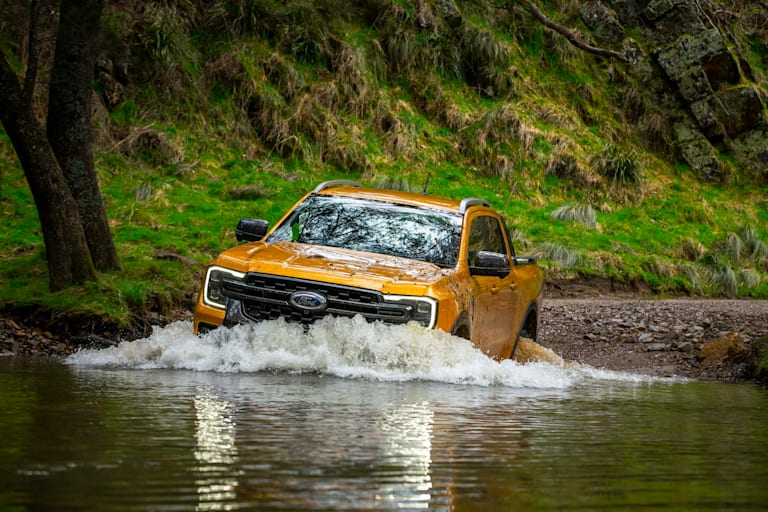
Gearing reduction is nice and low, as you’d expect with a 10-speed gearbox, and at no stage did I want or need hill descent control thanks to this low-range reduction
Various terrain modes, which alter things like throttle response and traction control calibration to better suit the terrain you are experiencing, proved to be helpful on test and are something both beginner and experienced off-roaders will benefit from using.
Those familiar with the Turon River area will know it is littered with water crossings and that the depth can vary from ankle deep to above your head seemingly overnight. During our visit, it was as deep as I’d want to take a stock four-wheel drive without a snorkel through, and on one occasion we saw water up over the bonnet.
The air intake is forward-facing in the engine bay, and I thought for sure we’d drowned the air filter. I was surprised on inspection that not a single drop of water had made its way in.
Ford claims an 800mm wading depth and we tested every millimetre of that claim, awarding the vehicle full points when it comes to water crossings. But I’d still fit a snorkel personally for peace of mind.
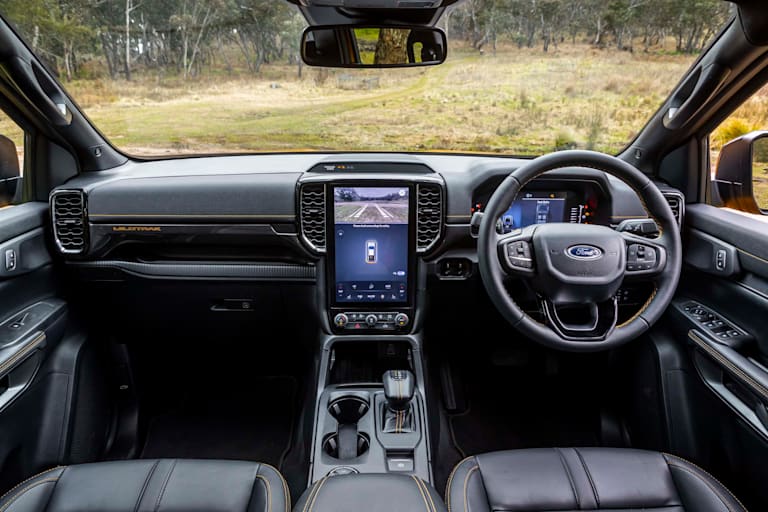
Cabin and accommodation
There’s a fair bit to talk about inside the top-spec Wildtrak, including a place to store your French fries. That's not a joke, by the way – there’s even a little chip packet logo inviting you to do so.
If you look up from the driver’s seat, you’ll notice an aircraft-style switch panel, with six switches that allow you to easily and neatly add aftermarket accessories such as driving lights, which is refreshing to see.
Blank switches for accessories are few and far between elsewhere in the cabin (I counted one), so you’d have to run something like ARB’s Linx system to add gear otherwise.
The interior door handles also caught me off guard as you don’t pull a lever to open the doors, you squeeze the handle. I found this actually easier to use than a more traditional door handle, so there must be method to the madness. In the back seat area, there is storage under the seat, very useable storage at that.

With the back seat folded down, I dare say you’d be able to squeeze a slimline lithium battery in there, which in my opinion is a great place to store a second battery (most lithium batteries don’t like to be mounted in engine bays).
Design-wise, Ford has done an excellent job of the Ranger Wildtrak's interior styling and layout. It is very dark with loads of black plastic, but with orange stitching to offset this.
The seats are really comfortable too; my wife especially appreciated the heated seats on a cold run up to Katoomba, as well as the wireless phone charger.
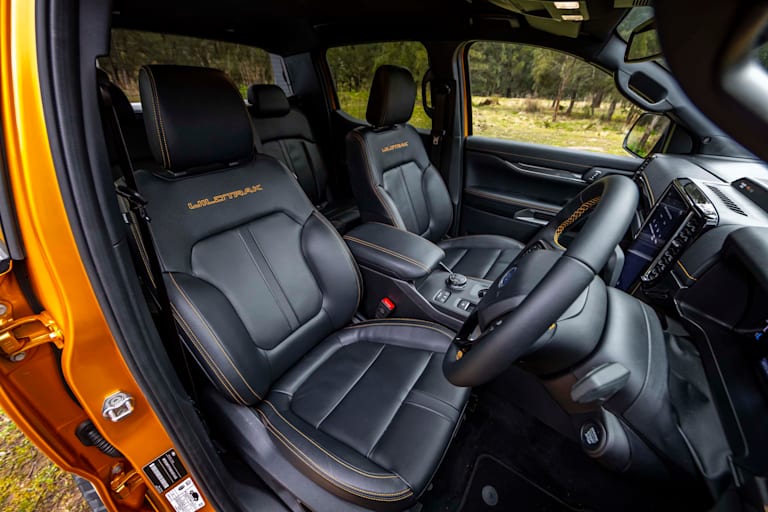
It’s impossible to ignore the massive infotainment screen mounted neatly onto the dash, which really is the brains of the vehicle
I found it intuitive and quick to operate, but gee I’d hate to see how much one would cost if you had to replace it. However, having most controls operated via the touchscreen neatens up the dash area considerably, and I appreciated seeing actual dials for things like volume control.
If I had to sum it up, the new Ford Ranger Wildtrak feels like a cross between a HiLux and an Amarok – it’s super comfortable and luxurious inside, yet capable and practical off-road. I really feel the Wildtrak is the model to get too, as the extra money you pay for it feels well spent.
I normally prefer simpler base model four-wheel drives and put the savings into accessories, but I’d absolutely spend the extra coin here and go with the Wildtrak's many extra useful features and plush (for a ute) interior.
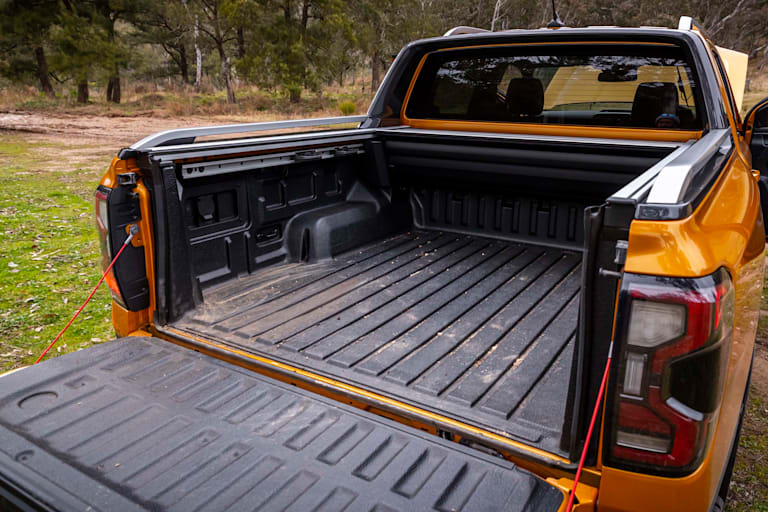
Practicalities
With 1200mm of cargo storage space between the wheel arches, as well as plenty of adjustable tie-down points and LED lighting in the tub, the Ranger is as practical as it gets really.
The steps on the side of the tub are also a simple yet well-executed inclusion, as is the electronically operated roller hard lid that can be operated from inside the vehicle as well as via a push button in the tub.
Towing capacity is listed at 3500kg, as you’d expect, however personally I’d not feel comfortable towing that much with any vehicle – but that’s just me. Payload capacity is an impressive 997kg, allowing a fair margin for those wanting to accessorise their Ranger with things like bull bars and winches.
Speaking of accessories, you can have a Ranger built up through your Ford dealership with ARB accessories, which is not only convenient but tells me Ford wants you to make your Ranger your own and build it up for your needs. It’s refreshing to see.
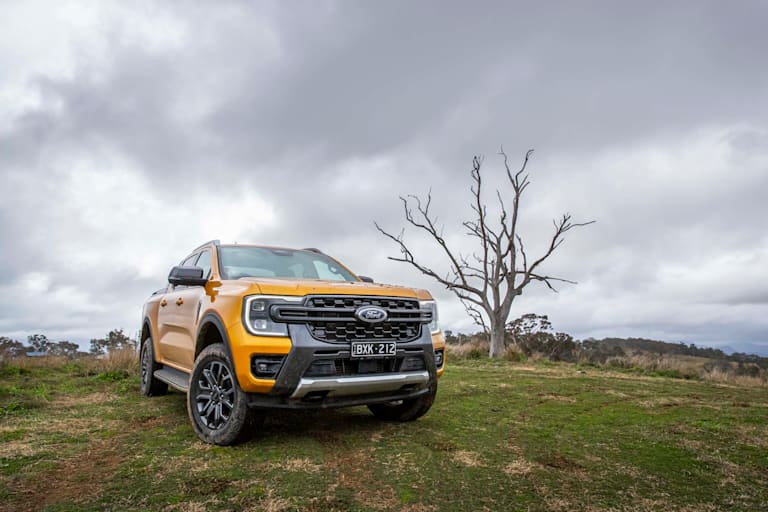
VERDICT
You’d bloody want it to be good. It needs to be.
This is the part of the article where you expect me to tell you the new Ranger is the best ute on the market, and you all ask how much Ford paid me to do so, right? Well, in my own opinion, the V6 Wildtrak Ford Ranger is the best ute on the market today, and I say that as a HiLux owner.
You’d bloody want it to be good though, it needs to be. Competition in this sector is getting fiercer by the week and I look forward to seeing what other manufacturers come up with to compete with the new Ford Ranger.
I am also aware it is a new model, and we don’t yet know of or understand any potential flaws or weaknesses that can arise from any new-generation vehicle. Not that I’m saying there are any, I’m just old school.
Were I in the market for a new four-wheel drive ute, the Ranger – particularly in Wildtrak trim – would be at the top of my list. However, I’d be waiting a year or two before buying one personally.
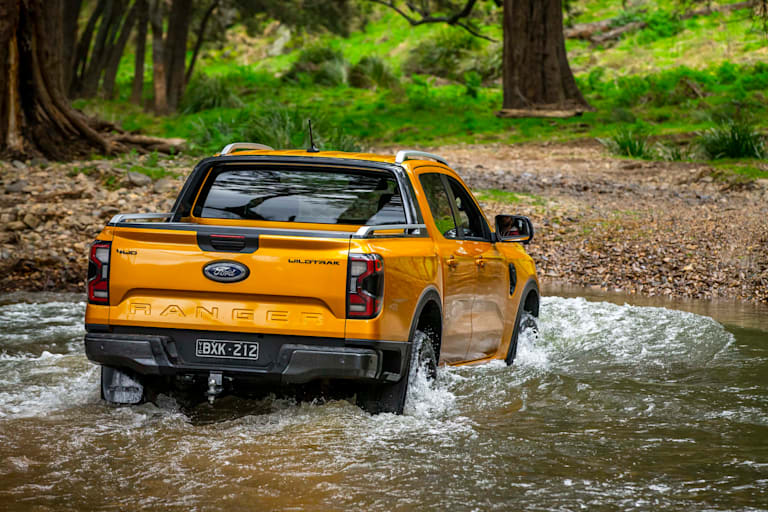
It is the perfect blend of being practical, capable, powerful and comfortable, a very long way away from the utes of the late 90s and early 2000s, which were commercial vehicles first, passenger vehicles second.
On my wish list if I purchased a new Ford Ranger would be a suspension lift and larger tyres, as on test the ground clearance proved to be an issue, with the side steps and underbody protection plates coming into contact with Mother Nature more often than I like.
The good news, however, is that’s about all it needs to be a solid performer in all areas, and these aftermarket accessories are available via the dealership (or other aftermarket accessory outlets) thanks to Ford's partnership with ARB, which is a great initiative that more manufacturers should follow.
Ford has built a vehicle for the people who are actually going to use it – and for that, I say job well done.
2022 Ford Ranger Wildtrak specifications
| Engine | 3.0-litre V6 diesel (single turbo) |
|---|---|
| Max power | 184kW @ 3250rpm |
| Max torque | 600Nm @ 1750-2250rpm |
| Transmission | 10-speed automatic |
| 4x4 system | permanent four-wheel drive |
| Construction | body on ladder frame chassis |
| Front suspension | independent with coil-over struts |
| Rear suspension | solid axle with leaf springs |
| Tyres | 255/65 R18 Goodyear Wrangler Territory AT/S |
| Tare weight | 2353kg |
| GVM | 3350kg |
| Payload | 997kg |
| Fuel tank | 80 litres |
| ADR fuel claim | 8.4L/100km (combined) |
| On-test fuel use | 10.0L/100km |
| Departure angle | 23 degrees (with towbar) |
| Approach angle | 30 degrees |
| Rampover angle | 22 degrees |
| Wading depth | 800mm |
| Price | $70,190 + on-road costs |
Score breakdown
Things we like
- Refinement and performance of the V6 engine
- Comfort on- and off-road
- All-wheel drive ability on-road
Not so much
- Lack of ground clearance in stock form
- Could do with bigger tyres (name a 4x4 that doesn’t)
- Gear selector annoying to operate

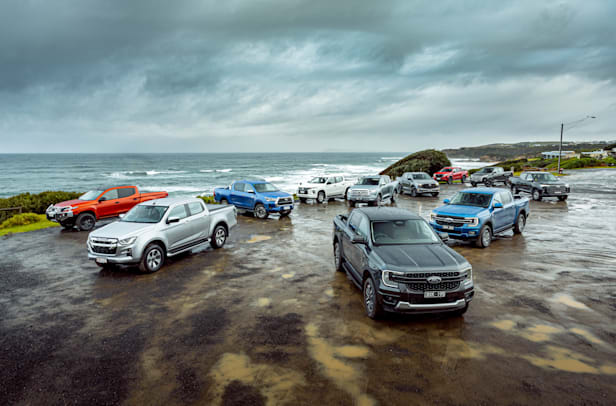

COMMENTS